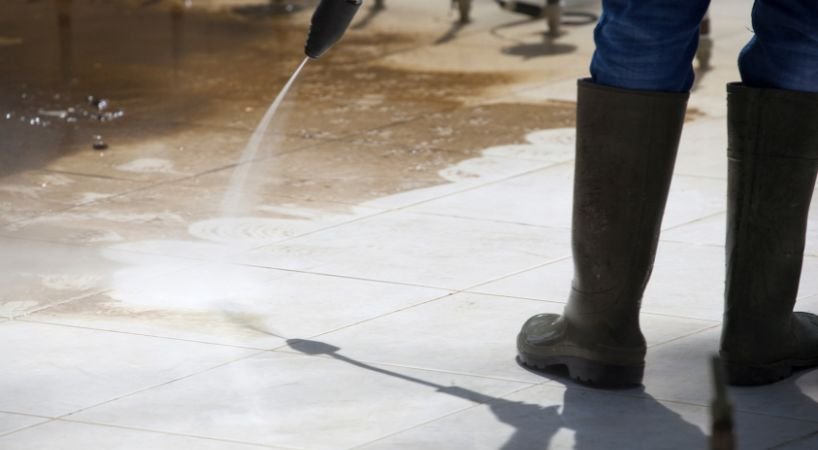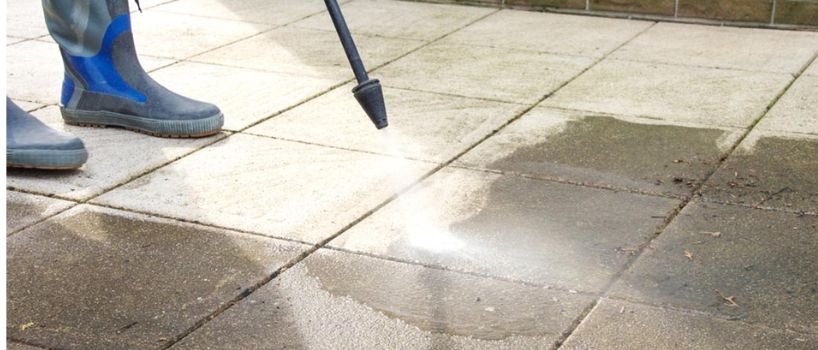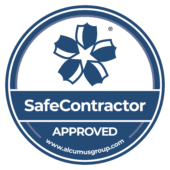Your patio is subject to the turmoil of the great outdoors on a daily basis. It has to withstand wind, rain, frost, mud, and everything in between. There's no wonder why patio slabs end up grimy! But with the right tools and the right information, you can take your patio slabs and get them looking brand new. All it takes is a little bit of patio cleaning with our patio cleaning services. This is where EMS Powerwash comes in.
No hassle, no obligation—just a fair price for top-quality cleaning.

If your patio slabs aren't super dirty, you don't need to use an intense patio cleaning method. You can just rely on the garden hose or a bucket of warm water and some soap. This is referred to as the soapy water method and simply uses a warm water solution to clean light marks and grime off of the patio slabs.
Start by squeezing a little washing up liquid into the bottom of your bucket. Fill the bucket with warm water until you've got enough to use, and if need be, stir it a little to encourage the water to lather up.
Starting from the top corners of your patio, splash some of the water onto the patio. Then, using your stiff brush, scrub the patio gently. You should be able to see the dirt coming off the patio as you scrub the surface.
Continue with this technique across the whole patio. Once done, either fill the bucket with clean water or use the garden hose to rinse the patio slabs. You should aim the water towards a drainage point if possible.
Leave your patio to dry! Once dry, you can return any garden furniture and other garden accessories back.
At EMS Powerwash, we offer expert cleaning services for homes and businesses across the East Midlands. Our team uses the best tools and techniques to make your property look brand new. No matter the job, we deliver reliable, high-quality results every time.
Just like the above method, this patio cleaning technique avoids using the pressure washer, making it great for DIYers. It also uses a non-chemical patio cleaner, making it environmentally friendly and is easy to do.

Mix water and vinegar together in a 1:1 ratio. This means using the same amount of both in your bucket to create the perfect cleaning solution for your paving slabs. For dirtier patios with deeper or more stubborn stains, you might need to use more vinegar than water, but you can judge this for yourself.
Pour your water and vinegar cleaning solution over your patio and leave it for up to an hour to work. Once done, rinse with clean water and leave your patio to dry. You should find that even stubborn dirt and stubborn stains rise with this technique. If they don't, you can always repeat the technique.

If you've got a particularly dirty patio, or you're looking to get a large patio finally clean, you might need to use the pressure washer technique. This is a risky process. If you do the pressure washer method wrong, you could risk damaging your block paving or patio slabs during the patio clean.
You will need somewhere to put the pressure washer plug in, so you may need outside power or the ability to run cables out to your garden safely in order for the pressure washer to work. We have a fantastic pressure-washing service.
Depending on the model of the pressure washer, you may or may not have a detergent chamber. If you do, add your patio cleaner into the chamber (dilute according to the manufacturer's instructions first). If you've not got a chamber, the patio cleaner can be poured straight onto the patio, so long as you're not dealing with natural stone or a particularly harsh pressure-washing solution.
As with the other methods, start in the top far corner and, holding your pressure washer at a 30-degree angle, you can start to spray the patio. Be sure to stand a little bit away as the jet of water is incredibly strong. You should spray across the patio in diagonal motions.
Once you've seen the dirt lifting from your patio stones, you should rinse away any standing water using a hose or a bucket of water.
If you don't know what material your patio is made from, or what state it is in underneath the grime, then using a pressure washer is a risk. Pressure washers rely on very high pressure streams of water blasting the dirt away. These jets of water can often cause holes and cracks.
This is also true if you do not know how to use a pressure washer. Choosing to try it for the first time as a patio cleaner for your paving slabs is a risk, and is likely not to end well. Your best bet is to contact professionals like EMS Powerwash to help you with your patio cleaning needs.

Before any cleaning technique, you should sweep your patio to remove debris. Debris can get thrown around by pressure washers and can make cleaning by hand frustrating! Simply sweeping loose debris away with a stiff broom before you begin will make the patio cleaning job much easier.
Lots of people have patio furniture, garden furniture and other garden accessories. These should always be moved out of the way before you start to clean your patio. One, they'll be in the way, but they may also get damaged!
In addition to the patio surface itself, you should make sure that you regularly clean the patio joints. These are the thin lines between each patio slab. This should usually be done before you clean your patio slabs, as it may result in mode and debris scattering out across the patio slabs, which you can then remove when you start cleaning patio slabs.
You should use a joint scraper to remove weeds (a garden spatula will do if you do not have one of these), or, if you are able to, a cordless weed remover. The easiest option by far, though, is hot water. This breaks down the weed, killing it immediately.
Natural stone (granite, marble, sandstone and limestone) are relatively robust. As a result, they are often used for things like patios, as they also look fantastic. The issue is, though, that natural stone has natural divets and space on its surface which dirt and organic material are able to gather in. This makes it even more important to clean paving slabs made from these materials.
However, some natural stone slabs must be handled delicately. Some natural stone (granite and basalt) can withstand the pressure washer or patio cleaner, but when it comes to other, softer stones, using a high-pressure cleaner will just damage the patio rather than cleaning patio slabs. In these cases, the cleaning must be done at low pressure, or by hand.
Concrete is also sturdy, but it is very absorbent as a material. For this reason, when you're cleaning concrete patio slabs it is vital that you use less water. Often, this means not using a pressure washer. Scouring sand can be very helpful in this situation, as it removes stains from the patio surface. Using a little warm water and a scrubber should work to remove green deposits and organic growth from concrete paving slabs. We could in this instance use DOFF cleaning service or TORC cleaning service.
No hassle, no obligation—just a fair price for top-quality cleaning.

In addition to cleaning your patio, you can do a few things to maintain it. This stops cleaning your patio from becoming one of those tough cleaning jobs that you put off for days.
Regardless of whether you have a block paving, concrete or natural stone patio, regular sweeping is a great way to avoid stubborn discolouration stains. It prevents anything from sitting on your block paving or concrete and causing a stubborn mark. Sweeping your patio is an easy task and, especially in high traffic outdoor areas, could save you a lot of work!
If you do find that you get stains on your patio, you should treat them as quickly as you would if they were indoors. Stains are almost inevitable, whether they're caused by weather and natural things or by a friend dropping some sauce at a BBQ. But by tackling them sooner rather than later you can prevent them from becoming hard to remove.
Since your patio is outside, when you use harsh chemicals on it, they end up being swept into the environment. This is really bad for the local ecosystem, and so it is always worth trying to find environmentally friendly solutions when it comes to cleaning products. In addition to helping the environment, this should prevent the products from discolouring your patio, and is better for pets and children.
The best way to keep your patio safe between washes is to use a patio sealant. Acting as a protective barrier, a patio sealant will keep your patio slabs safe from any stains, marks and weathering, making it much easier to clean your patio!
Patio cleaning can be simple, but only if it's done regularly. If you've got a very dirty patio or a patio that's hard to clean because of the material, then you might find that it is worth contacting the professionals.
With all the training necessary and the right tools, the EMS Powerwash team can restore your patio slabs and breathe new life into the patio.

The best way to clean a patio typically involves pressure washing, as it effectively removes dirt, algae, and stains. However, the specific method may vary depending on the type of patio surface.
You should have your patio professionally cleaned at least once or twice a year, depending on the weather conditions and how frequently the patio is used.
Yes, we can remove tough stains like oil and rust from your patio using specialised cleaning products and techniques tailored to the specific stain type.
The cost to clean a patio varies based on the size and condition of the patio. We provide free quotes to give you an accurate estimate for your specific needs.
Pressure washing is generally safe for most patio surfaces, but some delicate materials may require a gentler approach, like soft washing, to prevent damage.
Yes, patio cleaning can effectively remove algae and moss, preventing them from making your patio slippery and unsightly.




